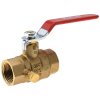I'm in the NC mountains, so NO water lines of any kind in attics here! ... but I have seen them only an hour south of me in SC. NOT fun working in a broiler hot attic in summer.
One thing I've found over the years working in the southern US Appalachian mtns is avoid the use of galvanized pipe like the plague! Whether connecting H20 heaters, or especially around well pump switches and pressure tanks... it WILL accelerate corrosion in the rest of the plumbing wherever there is metal (galvanic reaction), and it occurs rapidly when the H2O pH is below 7 (neutral), and with iron present in the water (it builds plugs pipe fittings). Might get away with it on treated municipal H20, but here in the mtns, well water is usually acidic and has at least some iron. Spring fed sources are often even lower pH and high levels of dissolved iron. Galvanized pipe, even short sections or fittings, will cause problems here in short order. Also, I started using electronic anode rod (cathodic protection) because old style zinc and even aluminum anode rods rapidly degrade, often producing nasty amounts of H2S in the water. Electronic anodes are a bit pricey, but extend the life of the tank substantially in harsh water environments. Where we are, it's common to have extensive H20 filtration systems, & softeners. Don't neglect maintenance if you have them, else you'll be replacing that new H20 heater much sooner than planned. Also, don't forget to check your line pressure frequently, especially on municipal H2O systems. Here in the mtns, it's not uncommon to see city water supply pressure to residences hit 300+ psi at night. Your H20 heater cannot handle that for long. So, most codes require use of a PRV (pressure reducing valve) at the water line entrance to the residence. Our code also now mandates use of pressure relief valves to dump excess pressure in event (when, not if) the PRV fails (and the do fail).
So, got that new H2O heater installed.. but don't forget, there are other items to check in the supply chain. Those often neglected items are the ones usually repsonsible for water heater failures.
Just my 2 cents, YMMV...







